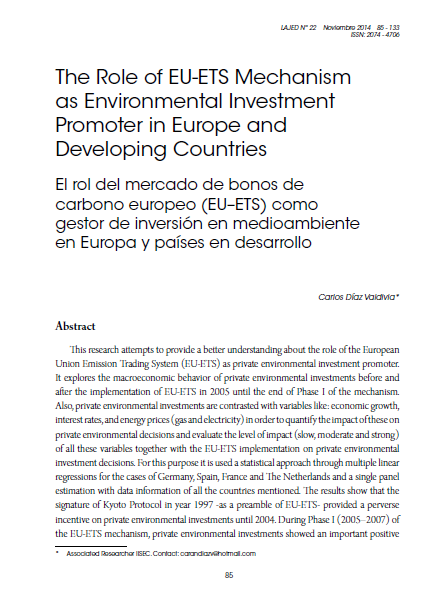El rol del mercado de bonos de carbono europeo (EU-ETS) como gestor de inversión en medioambiente en Europa y países en desarrollo
DOI:
https://doi.org/10.35319/lajed.20142282Palabras clave:
EU-ETS, inversión, medioambiente, mecanismo de desarrollo limpio, MDLResumen
Esta investigación intenta proveer una mejor comprensión acerca del rol que juega el mercado de bonos de carbono Europeo (European Union - Emissions Trading System) como gestor de inversión privada en medioambiente. Se explora el comportamiento macroeconómico de la inversión privada en medioambiente antes y después de la implementación del mecanismo en el año 2005 hasta el final de la Fase I del mismo. Además, la inversión privada en medioambiente es contrastada con variables como crecimiento económico, tasas de interés y precios de energía (electricidad y gas) con el fin de cuantificar el impacto de estas variables sobre decisiones de inversión en medioambiente y evaluar el nivel de impacto (pequeño, moderado o fuerte) de todas estas variables junto con la implementación del mecanismo de mercado sobre decisiones de inversión en medioambiente. Para este propósito se utiliza una aproximación estadística mediante las regresiones lineales múltiples para los casos de Alemania, España, Francia y Holanda y una estimación de datos de panel con la información estadística de todos los países mencionados. Los resultados muestran que la firma del Protocolo de Kyoto en el año 1997 - como preámbulo a la implementación del mecanismo EU-ETS- otorgó incentivos perversos hacia las inversiones privadas en medioambiente hasta el año 2004. Durante la Fase I (2005 - 2007) del mecanismo de mercado EU-ETS, las inversiones en medioambiente mostraron una recuperación positiva e importante que no fue suficiente para alcanzar los niveles vistos antes del Protocolo de Kyoto. Finalmente, se analiza la inversión en países en desarrollo a través de proyectos bajo el Mecanismo de Desarrollo Limpio (MDL).
Descargas
Citas
Barret, J., (2009). Arguments for Auctioning Carbon Permits. Clean Economy Development Center for Economics for Equity and the Environment Network.
Blanco, M. & G. Rodrigues (2008). “Can the future EU-ETS support wind energy investments?” Energy Policy, 36(4), 1509-1520.
Chatterjee, S. (1988). Sensitivity Analysis in Linear Regression. Wiley, First Edition.
Chester, L. & S. Rosewarne (2011). What is the relationship between derivative markets and carbon prices? Australian Political Economy. Department of Political Economy, University of Sydney.
Chevallier, J. (2012). Econometric Analysis of Carbon Markets: The European Union Emissions Trading Scheme and the Clean Development Mechanism. Springer Netherlands.
Dornbusch, R. & S. Fischer (2004). Macroeconomía. España: McGraw-Hill. 9º ed.
Ellerman, D. & P. Joskow (2008). The European Emission’s Trading System in Perspective. MIT Center for Energy and Environmental Policy Research.
European Commission (2005). EU action against climate change: EU emission trading – an open scheme promoting global innovation. European Communities.
Feilhauer, S. (2009). “Impact of European Emissions Trading System (EU-ETS) on Carbon Emissions and Investment Decisions in the Power Sector.” Massachusetts Institute of Technology (Master Thesis).
Graus, W., U. Sreenivasamurthy & B. Wesselink, (2009). EU climate policy impact in 2020 - With a focus on the effectiveness of emissions trading policy in an economic recession scenario. Ecofys.
Gudbrandsdottir, H. (2011). “Predicting the Price of EU ETS Carbon Credits: A Correlation, Principal Component and Latent Root Approach.” Reykjavík University, Iceland (Master Thesis).
Hoffman, V. (2007). EU ETS and Investment Decisions: The Case of the German Electricity Industry. European Management Journal, 25(6), 464-474.
Koenig, P. (2011). “Modelling Correlation in Carbon and Energy Markets.” Electricity Policy Research Group, Working Paper 1107 and Cambridge Working Paper in Economics 1123
Kossoy, A. & F. Ambrosi (2012). “State and Trends of the Carbon Markets.” Carbon Finance at World Bank.
Kumar, K. (2011). “Carbon Trading. Dissemination Paper Series. Centre of Excellence in Environmental Economics”. Madras School of Economics.
Lacombe, R. (2008). “Economic Impact of the EU-ETS: Evidence from the refining sector”. Massachusetts Institute of Technology (Master Thesis).
Larrain, F. & J. Sachs (2002). Macroeconomía en la economía global. Pearson Education, 2º edition.
Leguet, B. (2012). “Understanding the Link between Macroeconomic Environment and the EU Carbon Price”. Newsletter Nº 66, CDC Climat Research.
Milunovich, G. & R. Joyeux (2007). “The Temporal Links Between Spot and Futures Carbon Allowance Markets”. Division of Economic and Financial Studies Macquarie University.
North, D. (1990). “Institutions, Institutional Change and Economic Performance”. Cambridge University Press.
Obermayer, J., (2010). “An analysis of the fundamental price drivers of EU ETS carbon credits”. Royal Institute of Technology (Master Thesis).
Rogge, K. & M. Schneider (2010). “The innovation impact of the EU Emission Trading System. Findings of company case studies in the German power sector.” Ecological Economics, 70(3), 513-523.
Rogge, K. & V. Hoffman (2010). “The impact of the EU ETS on the sectoral innovation system for power generation technologies. Findings for Germany”. Energy Policy, 38(12), 7639-7652.
Schuttelaar, F. (2012). “Correlation between Carbon and Energy Markets”. Presentation at Workshop HEC Energy and Finance Chair. GDF SUEZ Trading.
Stern, N. (2007). The Economics of Climate Change: The Stern Review. Cambridge University Press.
Venmans, F. (2012). “A literature-based multi-criteria evaluation of the EU ETS.” Renewable and Sustainable Energy Reviews, 16(8), 5493-5510.
Zhang, Y. & Y. Wei (2010). “An overview of current research on EU ETS: Evidence from its operating mechanism and economic effect.” Applied Energy, 87(6), 1804-1814.





